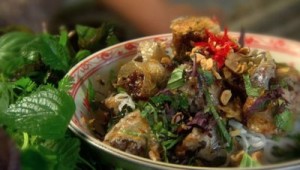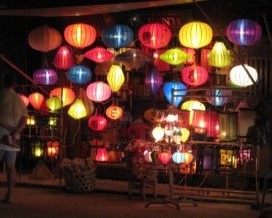 With its rich culinary heritage and an exciting street food scene, Hanoi is a wonderful city for many delicious dishes.
With its rich culinary heritage and an exciting street food scene, Hanoi is a wonderful city for many delicious dishes.
They say that the way to man’s heart is through his stomach; cook him a good meal and he’s putty in your hands. I’d argue that somewhat similarly, residents of Hanoi are happiest at mealtimes, and many visitors fall in love with the city because of its incredible food. It’s a place that gets to you through the stomach!
For foreign guests and residents, if you want to understand Hanoi and its people, I’d argue that you have to understand the cuisine and enjoy discovering new foods. If you love food, you will love Hanoi; understand how people eat, and you’ll understand their nature.
Vietnamese people love to share a meal. Solitude is equated to loneliness. Anyone dining alone will be told “an mot minh dau tuc”, literally, you’ll hurt yourself by eating alone. But for the solo diners amongst you, fear not, you can always slip into the busiest restaurant and enjoy the buzz of jostling with your fellow diners over a bowl of pho or a plate of sticky rice. You’re alone, yes, but alone in a crowd.
The first rule for discovering Vietnamese food in Hanoi, is make sure you follow the crowds; the busier the restaurant, the better it probably is. Certain family run establishments are considered the place to eat certain foods. At peak hours, it should be hard to find a space at Hanoi’s best restaurants.
The second rule is that the best restaurants serve one basic staple – it’s often a one-dish-joint serving a ‘gia truyen’-specialty, a recipe passed on from one generation to the next.
Many of these dishes were originally created elsewhere. As a thousand-year old capital, people from the provinces have always been drawn to Hanoi, so the city has absorbed recipes and cooking techniques from all over the country.
One can loosely define Hanoian cuisine – generally the capital’s residents don’t care for sweet or spicy savoury food; there is a preference for fresh ingredients and subtle, pure flavours, and the fish sauce is served less diluted.
Certain dishes are year-round staples, such as pho (the nation’s signature noodle dish served with chicken or beef), bun cha (noodles served with slivers and patties of charcoal-grilled pork) or banh cuon (rice crepes filled with pork and woodear mushrooms). Other dishes are seasonal, perhaps, tied in with a festival, for example, banh chung (glutinous rice cakes stuffed with mung bean paste and pork and wrapped in a green banana leaf) is mostly served at Lunar New Year. During Mid-Autumn Festival (Tet Trung Thu), you will see mooncakes, sweet and savoury cakes filled with various things, including bean paste, salted egg, or preserved fruits and meats.
Other foods are associated with the lunar calendar. Eating dog meat – served in seven different ways at dog restaurants – at the end of the lunar month is considered a good way to wash away any lingering bad luck that might have been affecting you. The dog restaurants on Au Co road are often heaving with customers, mostly men, as this protein-rich meat is also considered to be “good for a man”.
On the full moon of the first and the seventh lunar months, Hanoians often cook xoi vo (steamed sticky rice with split peas) and che duong (green bean and sugar compote). When worshipping ancestors, boiled chicken with lemon leaves is a must. For a wedding, you cannot be without banh com (Sticky rice cakes with green bean paste) or xu xe/ phu the (Husband and wife sticky rice cakes).
Hanoi people love seafood, too. The city’s favourite fish dish is probably cha ca, which is famously served by a gruff family at Cha ca La Vong restaurant on Cha ca street in the Old Quarter. It is featured in every guidebook ever written about Hanoi. However, cha ca is now available in other restaurants and locals in the know complain that the quality of food at Cha ca La Vong has waned.
Bun oc (noodles and snails), banh tom (prawn fritters), ca kho to (caramelised fish cooked and served in a claypot), and mien luon or mien cua (glass noodles served with eel or crab meat) are also much loved in Hanoi. You can find seafood restaurants serving all kinds of shellfish – crabs, lobsters, oysters, clams and scallops, which are often simply steamed or grilled and served with a mixture of lime, pepper, salt and an optional diced chili for dipping.
New dishes are constantly surfacing, too. In recent years pho cuon, sheets of banh pho, wrapped around either beef or shrimp, has suddenly emerged as one of the city’s most popular meals. However, the ultimate communal dish is perhaps lau (hotpot), always popular in wintertime. Friends and families gather around a steaming pot filled with a vegetable or meaty broth and toss in fish, meat, eggs, vegetables, squid, or prawns – just about anything at all!
It’s hard to write about food in Hanoi without feeling like you’re only scratching the surface. As the city celebrates 1,000 years since its birth, you could probably name a 1,000 dishes to honour the capital’s millennium.
The city’s culinary heritage has been noticeably influenced by a few old foes over the years. Some people argue that pho is the product of both French and Chinese influences. From the former came the notion of using beef stock and beef in the style of pot-au-feu; from the latter perhaps the noodles and the use of star anise and ginger. Using beef would have been quite extravagant 100 years ago, so one theory is that the Vietnamese only started putting beef in their noodle soup to please the French colonists.
The French certainly left their fingerprints in the Vietnamese pantry and beverage department – you can find banh my (crusty baguette) served with pâté. The words for butter (bo, pronounced ‘buh’), coffee (ca phe), beer (bia) and cheese (pho mat) are clearly derived from the French language.
Today, many French chefs are inspired by Vietnam’s indigenous ingredients and recipes. Restaurants such as La Badiane, Green Tangerine and La Verticale are creating a vibrant amalgam of French haute cuisine infused with local flavours and ingredients. These restaurants are something of a sub-genre but they are also encouraging some high-end travelers to venture further and discover more about Vietnam’s culinary arts.
As Vietnam’s reputation grows, more and more people are discovering the country’s incredible cuisine, much of which is exceedingly healthy. Visitors to Hanoi are enthusiastically signing up for cookery classes, in the hope of learning how to create a local dish or two. Rather than buying a conical hat or a silk ao dai as a souvenir that will be stashed away and never worn back home, tourists can now pick up some noodles and fish sauce in the local Asian market and whip up a delicious bowl of bun cha, they learned to make on their holiday.
That way they’ll remember Hanoi as they first experienced it – right in the stomach.
Timeout/VOVNews




